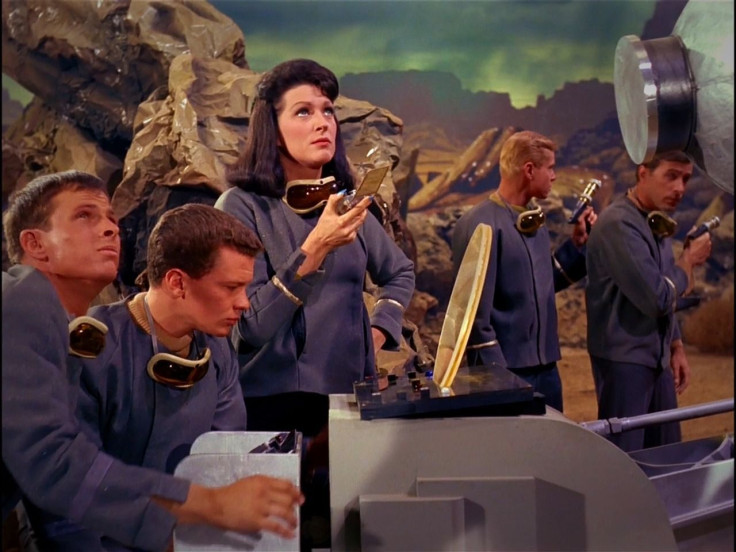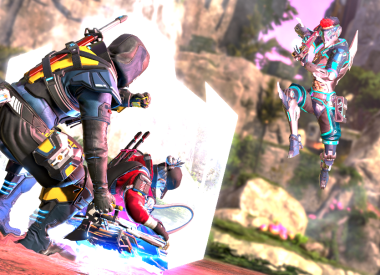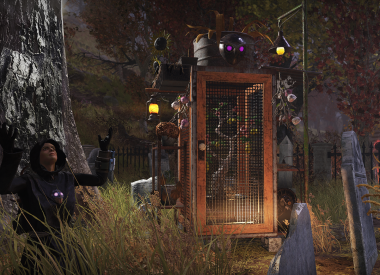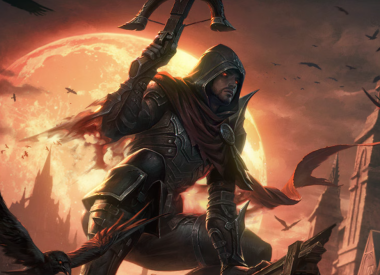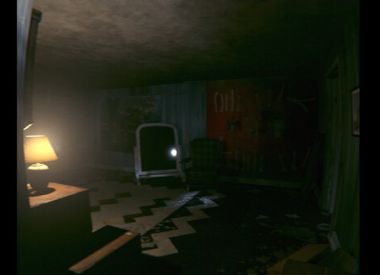As the Sept. 24 premiere of Star Trek: Discovery approaches, Player.One will profile essential episodes to watch for a better understanding of the characters, species and history informing the first Star Trek series in over a decade.
In the beginning, women were a mystery to Star Trek, sometimes a nuisance. Gene Roddenberry’s original series proposal described Captain Robert April (later changed to Christopher Pike) as “colorfully complex, capable of action and decision… lives a continual battle of self-doubt and the loneliness of command.” Dr. “Bones” Boyce was “humorously cynical… enjoys his own weaknesses.” Number One, a role written for actor Majel Barrett, was “a mysterious female, slim and dark, expressionless, cool, one of those women who will always look the same between years 20 and 50.”
But despite Number One’s essential emptiness as a character, originally defined by her looks and what people didn’t know about her, Majel Barrett as Number One in “The Cage” (Star Trek’s rejected first pilot) inspired both what Star Trek became and what it will become. Though much has changed since Bryan Fuller left Star Trek: Discovery, his hand-picked lead, Sonequa Martin-Green as First Officer Michael Burnham, was originally created in honor of Star Trek’s first woman.
“When we introduce our protagonist, she is called Number One for that very reason, in honor of Majel Barrett’s character in the original pilot,” Bryan Fuller told the Nerd World Report radio show in 2016. “As we were first talking about the series and first talking with CBS, we said initially we’re only going to call this character Number One.”
Which is why “The Cage” is one of the most essential Star Trek episodes to see before Star Trek: Discovery premieres on Sept. 24. Shot in 1964, nearly two years before Star Trek would finally premiere with “The Man Trap” on Sept. 8, 1966 (capturing 47% of that night’s TV viewing audience), “The Cage” is a Twilight Zone look into an alternate reality, where Star Trek sucks. It dramatizes just how special Star Trek is, taking viewers on a tour of the many possible ways the series could have failed to become the Star Trek we know.
After detecting an old distress signal, the Enterprise sends a landing party down to Talos IV and finds stranded human scientists where none should be. It’s a psychic illusion, projected by the big-headed Talosians to lure Captain Pike into their collection of specimens (including woeful-even-for-Trek “aliens” in gorilla and chicken suits). They live only for illusions, feeding on the emotional experiences of their captives, with future plans to breed Pike and a captive woman named Vina to use as slave stock in rebuilding their crumbled world. Just in case the cycle of illusory temptations and punishments wasn’t an obvious enough reskin of Christian devil’s bargain morality fables, the Talosians ask Captain Pike, at the sight of a dancing Orion slave girl (one of Star Trek’s more repulsive inventions, there from the beginning), “Wouldn’t you say it’s worth a man’s soul?”
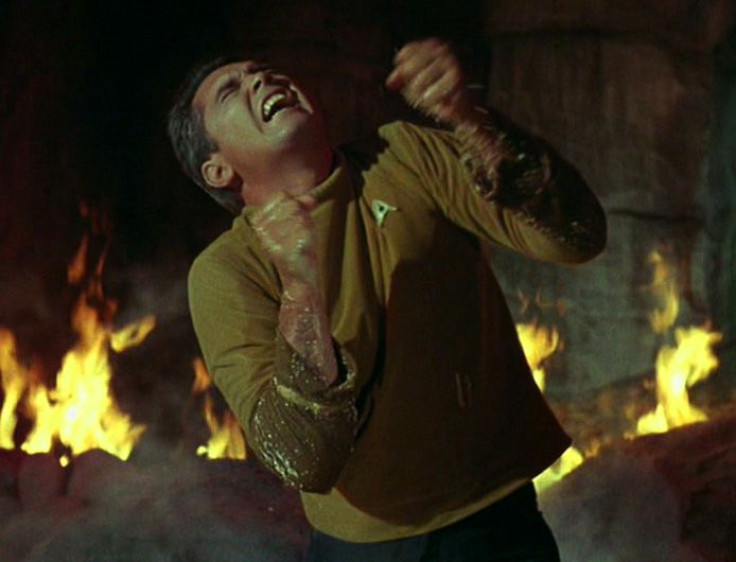
It’s a bad plot. While Pike dunders his way through Talosian illusions, Number One and Spock spend most of the episode trying progressively more powerful laser blasts on an elevator door. But while “The Cage” is boring, with boring characters — a naval melodrama with sliding doors and purple skies — it’s still fascinating viewing, particularly for Star Trek fans already familiar with TOS. Weird, cool effects, like the opening theme ending with the camera phasing through the dome and onto the bridge serve as a first draft of sorts for the “real” Star Trek to come (footage from “The Cage” would be recycled for “The Menagerie” Season 1 two-parter).
Despite her lack of a biography beyond “mysterious female,” Number One ends up one of the more interesting characters in “The Cage.” Jeffrey Hunter is deadly dull as Captain Pike and John Hoyt as Dr. Boyce has got nothing on DeForest Kelley. Spock has the ears, but few of the other Vulcan traits. A Spock who emotes isn’t much Spock at all.

Instead, it’s Number One who is most purely logical, even using math in competition with Vina for the role of Eve to Captain Pike’s Adam. “They’d have more luck crossing him with a computer,” Vina tells Number One. “Well, shall we do a little time computation…” Number One replies, running through the math to accuse Vina of being too old for Pike. This human Vulcanness will be key to Michael Burnham in Star Trek: Discovery too: she’s a human raised by Vulcans.
In case Vina and Number One tearing into each other in a heated competition to become alien breeding stock wasn’t clear, “The Cage” uses its women as fantasy objects, fighting over Captain Pike. Even the careerist, supremely confident Number One pines for a more traditional domesticity. The Talosian illusions, ostensibly Star Trek tsk-tsking us about temptation, are leering, situating the viewer in the same creepo voyeur seats as its pervy aliens. In the end, Captain Pike leaves Vina prisoner with the Talosians, because only they can maintain the illusion of her beauty and hide her ugliness from her.
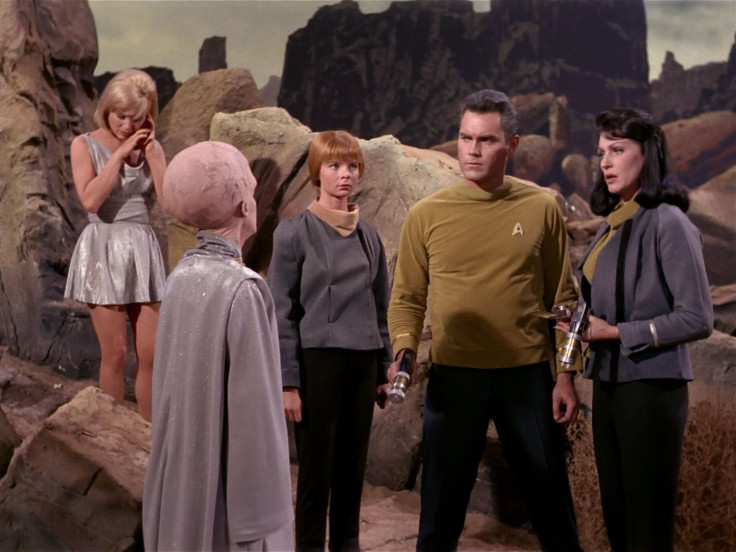
As much as Star Trek works toward more diverse and more humanist utopian visions of the future, the history of the series, like the history of the vast majority of TV, is partially a record of our patriarchal cultural institutions at work. But “The Cage” is even more egregious than most Trek. And with that, Star Trek: Discovery is likely to be just as much a refutation of the first Star Trek “values” as a tribute to Number One and the series’ ideals.
When Star Trek: Discovery begins, First Officer Michael Burnham serves under Captain Georgiou (Michelle Yeoh). Set in the Star Trek timeline just a year after “The Cage” — 2254, 11 years before the Enterprise’s five-year mission — Star Trek: Discovery puts two women in control of the bridge of a starship. Captain Pike wouldn’t approve, making “The Cage” Star Trek: Discovery's dark shadow just as much as its inspiration.
“I can’t get used to having a woman on the bridge,” he says in “The Cage,” before turning to Number One, “No offense, lieutenant, you’re different of course.”
Star Trek: Discovery premieres Sept. 24 on CBS.
More Essential Star Trek Episodes To Watch Before Star Trek: Discovery
Star Trek: The Original Series “The Cage,” model for DSC protagonist Michael Burnham.
Star Trek: The Original Series “Errand of Mercy,” our introduction to the Klingons.
Star Trek: The Original Series “Journey to Babel,” the first Sarek episode.
Star Trek: The Next Generation "Sarek" and the decline and death of Spock's father.
Star Trek: The Animated Series "Yesteryear" reveals what life was like for a young Michael Burnham as a human on the planet Vulcan.
Star Trek: The Next Generation "Lower Decks" explores stories and characters away from the bridge.
Star Trek: The Next Generation “Rightful Heir” resurrects Kahless, the most important Klingon religious figure.
Star Trek VI: The Undiscovered Country, the best-yet depiction of Federation-Klingon relations.
Star Trek: Deep Space Nine “Trials and Tribble-ations” explores the limits of nostalgia.
Star Trek: The Original Series "A Private Little War" takes Kirk, Bones and Spock to Vietnam.


